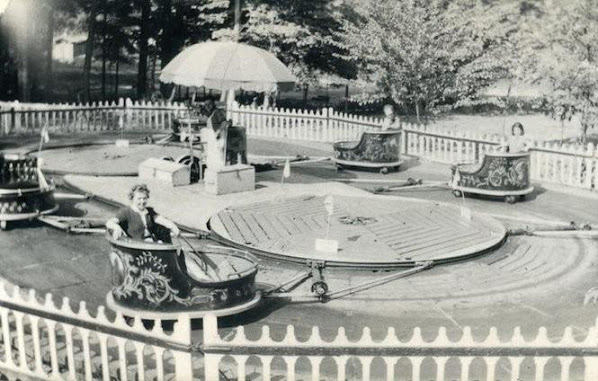
Much of the text below is taken directly from The History Of Knoebels. I've added assorted old photos of the items mentioned in the early history, as well as some additional history.
An early photo of the Knoebel family on the grounds
"In 1828, Reverend Hartman Henry Knoebel purchased a plot of land in central Pennsylvania, known then as “Peggy’s Farm.” That land was eventually passed down to his grandson, of the same name. There, the younger Henry developed a lumbering and sawmill business.
Running through the center of the land, Roaring Creek, drew the attention of local townsfolk looking for a place to relax and cool off on hot summer days. While the locals enjoyed creek side picnics and jumping off the covered bridge into the swimming hole below,
Ole Hen saw opportunity. He offered to feed and care for the horses parked on his farm for a mere 25¢.
The swimming hole soon sparked an idea for the enterprising Henry.
In November of 1925 he began construction on large pool, in the same location where the Crystal Pool resides today.
On July 4, 1926, Knoebels officially opened.
In the winter of 1948, the Alamo was built where the restaurant stands in the above photo.
That same year Henry also opened a restaurant on the grounds, and featured a steam-powered carousel operated by Philadelphia businessman, Joe Gallagher.
From the beginning, families wished to spend time in Knoebels’ forested beauty. The Great Depression arrived in 1929, and during this time, no additional rides were added. But with the sawmill located on the ground, plenty of lumber was available to construct picnic pavilions and private cottages.
Many families built cottages along the banks of Roaring Creek, several of which remain today. Others camped on Knoebels’ grounds, but it wasn’t until 1963 that Knoebels introduced its first six official campsites. Since that time the campground has grown to encompass over 550 sites and 57 log cabins. In 1996, Knoebels also acquired the nearby Lake Glory Campground.
The Shamokin & Mount Carmel car 33, was originally used to shuttle coal miners during shift changes at the mines. Abandoned sometime in a field near Shamokin in the 1930s, it was purchased by Knoebels in the 1940s for use as a cottage at the park. "Toonerville 33" was painted on the side, a reference to a popular newspaper cartoon known for its quirky country trolley. Sometime around 1980, the trolley was moved under a pavilion and used as storage for a woodcarver in the park. In August of 2023, the car was moved to the Pennsylvania Trolley Museum in Washington Pa, where it will become part of a display on how trolley cars lived on after they were no longer used for transit.
When the Gallagher Carousel was replaced by the Grand Carousel, the original building had to be enlarged to accommodate it. The Gallager carousel, owned by Knoebels, continued to be rented out for use at fairs and carnivals. In 1948 it was sold to Toby Amusement Park, where it was destroyed by flooding from Hurricane Diane. One of the hand carved horses was saved, and is today located in the Knoebels Carousel Museum.
With the acquisition of the carousel, came the addition of two organs, an 1888 Frati and Co., and an early 20th century organ by Ge- 2 bruder Bruder Co. A beloved tradition, Knoebels remains one of only a handful of places where guests can still catch a brass ring and earn a free ride on the carousel.
The second ride at the grounds opened in the mid 1930s. Called a HeyDey, it was owned and operated by a man from Shamokin. The ride was similar to a Tilt-A-Whirl, with heavy metal spinning four seater cars that traveled at high speed on an oval wavy steel track. It only lasted a few years, the operator not being dependable and often not showing up to operate it.
In the 1950's, there was a dance floor located where the Italian Trapeze Swings are today. The Donkey Kick was a shooting game.
In 1960, Pete Knoebel, made plans to honor his late father, Henry, with the purchase of the Pioneer Train. Henry had long dreamed of installing a small train to take riders through the woodlands that surrounded Knoebels. Purchased from Allen Herschell Co.’s Miniature Train Division, the track stretches a pleasant 1½ miles through the backwoods of the park, where riders can appreciate all sorts of wildlife from squirrels and rabbits, to even the occasional deer.

























I remember riding both the Rocket Ship and the Dinosaur as a little kid.
ReplyDelete